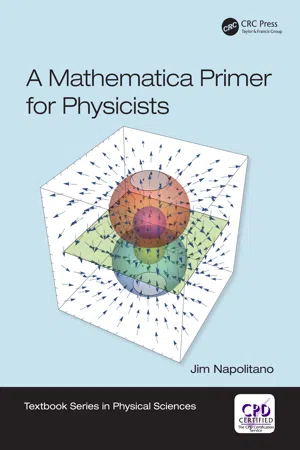![]()
Contents
CHAPTER 1 Introduction
1.1 GETTING STARTED
1.2 BUILT-IN OBJECTS
1.3 FUNCTIONS
1.4 SIMPLE PLOTTING
1.5 GOOD HABITS FOR WRITING NOTEBOOKS
1.6 PHYSICS EXAMPLE
1.7 GETTING HELP
1.8 CHAPTER SUMMARY
CHAPTER 2 Solving Algebraic Equations
2.1 SYNTAX FOR EQUATIONS AND SOLUTIONS
2.2 LIST MANIPULATIONS
2.3 SYSTEMS OF EQUATIONS
2.4 COMPLEX NUMBERS
2.5 PHYSICS EXAMPLES
2.6 CHAPTER SUMMARY
CHAPTER 3 Derivatives, Integrals, and Series
3.1 DERIVATIVES
3.2 INDEFINITE INTEGRALS
3.3 DEFINITE INTEGRALS
3.4 NUMERICAL INTEGRATION
3.5 POWER SERIES
3.6 PHYSICS EXAMPLES
3.7 CHAPTER SUMMARY
CHAPTER 4 Differential Equations: Analytic Solutions
4.1 FIRST ORDER ORDINARY DIFFERENTIAL EQUATIONS
4.2 SECOND ORDER ORDINARY DIFFERENTIAL EQUATIONS
4.3 SIMULTANEOUS DIFFERENTIAL EQUATIONS
4.4 PARTIAL DIFFERENTIAL EQUATIONS
4.5 PHYSICS EXAMPLES
4.6 CHAPTER SUMMARY
CHAPTER 5 Differential Equations: Numerical Solutions
5.1 ORDINARY DIFFERENTIAL EQUATIONS
5.2 PARTIAL DIFFERENTIAL EQUATIONS
5.3 PLOTTING IN THREE DIMENSIONS
5.4 PHYSICS EXAMPLES
5.5 CHAPTER SUMMARY
CHAPTER 6 Vectors and Matrices
6.1 VECTORS AND MATRICES AS LISTS
6.2 LOGICAL EXPRESSIONS AND OPERATIONS
6.3 VECTOR OPERATIONS
6.4 MATRIX OPERATIONS
6.5 EIGENVALUE PROBLEMS
6.6 PHYSICS EXAMPLES
6.7 CHAPTER SUMMARY
CHAPTER 7 Basic Data Analysis
7.1 NUMBERS IN LISTS
7.2 SELECTING DATA SEGMENTS
7.3 READING DATA FROM A FILE
7.4 MAKING HISTOGRAMS
7.5 PHYSICS EXAMPLE
7.6 CHAPTER SUMMARY
CHAPTER 8 Fitting Data to Models
8.1 LINEAR FITTING
8.2 NONLINEAR FITTING
8.3 HANDLING DATA WITH ERROR BARS
8.4 PHYSICS EXAMPLE
8.5 CHAPTER SUMMARY
CHAPTER 9 Numerical Manipulations
9.1 SIGNIFICANT FIGURES
9.2 NUMERICAL SOLUTIONS TO ALGEBRAIC EQUATIONS
9.3 WORKING WITH UNITS
9.4 ACCESS TO DATABASES
9.5 PHYSICS EXAMPLES
9.6 CHAPTER SUMMARY
CHAPTER 10 Random Numbers
10.1 GENERATING RANDOM NUMBERS
10.2 MONTE CARLO TECHNIQUES
10.3 PROBABILITY DISTRIBUTIONS
10.4 PHYSICS EXAMPLE
10.5 CHAPTER SUMMARY
CHAPTER 11 Animation
11.1 SCOPING
11.2 PLOTS IN MOTION
11.3 DRAWING GEOMETRIC SHAPES
11.4 CARTOON ANIMATION
11.5 PHYSICS EXAMPLES
11.6 CHAPTER SUMMARY
CHAPTER 12 Advanced Plotting and Visualization
12.1 OPTIONS FOR 2D PLOTS
12.2 OPTIONS FOR 3D PLOTS
12.3 CONTOUR AND DENSITY PLOTS
12.4 VECTOR DIFFERENTIAL CALCULUS
12.5 VISUALIZING VECTOR FIELDS
12.6 PHYSICS EXAMPLES
12.7 CHAPTER SUMMARY
Appendix A dditional Exercises
Appendix B Shorthands
Index
![]()
How to read this book
Look for bits of Mathematica commands that are set off from the text and in a different font, for example
(To execute this statement, press Enter while holding down the Shift key.) I generally follow statements like this with the resulting output. In this case,
The text around these pieces of input and output is there to help you understand the syntax, and to appreciate how to extend it.
Then, look at the example problems. Every chapter concludes with one or more “Physics Examples” that use the material up to that point to solve typical physics problems.
Many commands have “shorthands” and I use them from time to time, more often towards the end of the book. I’ve included an appendix to help you resolve them.
![]()
Preface
Most ...
